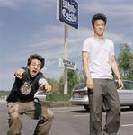|
|
||||
|
by Diana Saenger  In their new comedy, Harold & Kumar Go to White Castle, John Cho and Kal Penn are the Felix Unger and Oscar Madison of the 21st Century. This odd couple is about as different as they come. Harold Lee (John Cho) is an investment-banking clerk whose colleagues take advantage of his dedication and his brains. Harold’s roommate, Kumar (Kal Penn), is supposed to be following in his father’s footsteps and readying himself for medical school. Kumar is doing everything but facing that reality. While they are exact opposites as roommates, Harold and Kumar do share a love of Cho, Penn and director Danny Leiner sat down for an interview to talk about their film. Leiner, who grew up in the Leiner said he reacted to the humor in the Harold & Kumar Go to White Castle script, but also to the subtle undertones of the race card issue. “It was fresh and different. Not like two white guys or a white guy and a black guy, stuff we had all seen a lot. Among all the comedy, the racial stuff is layered in, and you can’t help but get their (Harold & Kumar) POV as people come at them with stereotypical views of them.” Kal Penn, American born of Indian nationality, is garnering quite an impressive list of film and TV appearances to his credit, but he can relate to the race issue in the film. “Some roles are so stereotypical, so it’s refreshing to play a role that wasn’t and to be able to comment subversively on depictions like that. I think that because you do it as funny you hope it changes people’s minds or progresses film a little more and shows people how ridiculous some of those depictions are.” Asian John Cho also had a say about the subject. “I think both Asian Americans and white Americans have had a tough time writing for Asian Americans correctly. It always feels that the race of the character seems to override the component of their identity in mainstream films, and it’s often the only identity of the character in Asian American movies. So it was cool about this movie that laughs are number one, and some of it comes from the race issue and some does not.” The comedy angle was the big appeal to both lead actors. “I liked that Harold is a three-dimensional character and a lead role,” said Cho. “Playing a sidekick usually stays at point A. I was excited to create an arc as well as have a closer relationship with the director. Kal, Danny and I were always conferring on what should people know at a certain point of the story.” “I’ve played sidekicks in mainstream movies and leads in independent films,” added Penn, “but never got the chance to play the title character in a movie role, and I’m a big fan of buddy movies. This is a very American road-trip story, and I like the randomness of the story. These guys are going through all these obstacles to get what they want, a hamburger, so it was challenging at the same time. I also enjoyed sitting down with the writer and director to help define the vision of the movie. Comedy was a big draw, but it was also about the character.” How hard was it for John Cho to play comedy when he’s a serious guy? “Kal and I both said we’d approach this as a dramatic role,” said Cho. “The irony of doing comedy is the more serious we are, the funnier the situations become. Harold is a serious uptight character and the more serious and uptight he was, the funnier the scene became. I knew I would enjoy watching the movie later and laughing, but comedy was not a part of making the film for me.” Like many of today’s pop culture films, Harold & Kumar Go to White Castle does have some drug content. Why do films need to keep doing the drug thing to get laughs? “The interesting thing about this movie is that these are real guys, an investment banker and a guy going to medical school, and frankly it’s a reality in our society that this exists,” explained Leiner. “I see a lot of the stoner stuff as kind of ghettoized, the goofy guys doing this, but this represents more of the reality of part of our culture. One of the biggest jokes in the movie is the drug commercial – marijuana kills. It’s one of the first big laughs in the movie, and I think people who are seeing this movie are keyed into this kind of big brother aspect of things. And when Harold and Kumar are smoking pot, a lot of bad stuff happens to them, so it’s not glamorized.” “When things that are stigmatized in society end up in some way on the screen, people tend to laugh at it,” added Cho agreed. “I was at a party after the test screening and an Asian woman said, ‘I love how the pot smokers are tie-dyed, hippie losers,’ and I said, ‘Wow that’s awesome that that’s what you picked up on.’” In the screening I attended people applauded after the film. Penn found this substantiated his decision to make the move. “To me that’s like a physical reaction to respond to something that the performers or anyone involved can’t see, and that’s that the writing is so good. That while they’re passively watching a movie they want to respond to it in some way, so they applaud.” “There is some great stuff about this movie,” added Cho. “In addition to the great set pieces, there’s also some substance – a love story between two guys and their burgers and between a guy and a girl. They’re just trying to get to Leiner, who founded Sly Dog Films with producing partner, Matt Tauber, is hoping to capitalize on a good audience response to Harold & Kumar Go to White Castle. “It depends on how the movie performs, but we set it up for a sequel in Meanwhile Sly Dog’s first film out of the gate is The Great New Wonderful, which Leiner recently completed directing with stars Maggie Gyllenhaal, Tony Shalhoub and Olympia Dukakis. “It’s an ensemble film of five stories that takes place in John Cho will next be seen in See This Movie and is busy with his band Left of Zed. “We’ve just recorded our first album, which we’re selling on our website www.leftofzed.com.” Kal Penn has a sitcom coming out this fall on NBC called The Men’s Room. “I also have two features coming up A Lot Like Love opposite Ashton Kutcher and Amanda Peet and Dancing in Twilight, a dramatic love story with Louise Fletcher and Mimi Rogers. All three of these professionals show the potential to bring viewers many other interesting characters and films in the future.
|
||
|
© 2025 - ReelTalk Movie Reviews Website designed by Dot Pitch Studios, LLC |




